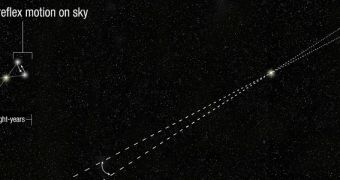A group of astronomers from the Space Telescope Science Institute (STScI) in Baltimore, Maryland, led by Nobel Prize laureate Adam Riess, announces the development of a new technique for precisely measuring the distance between the Sun and stars located less than 10,000 light-years away. Below this threshold, readings collected with the NASA/ESA Hubble Space Telescope become very precise.
There is always some degree of uncertainty associated with measuring distances in space, particularly if the objects targeted by researchers are located very far away. The new method reduces this uncertainty to almost zero for stars that lie up to 10,000 light-years away. Though this is a relatively short distance, the method confers precision for distances 10 times farther than previously possible.
The approach involves using a technique called spatial scanning, which allows the 24-year-old telescope to produce extremely detailed angular measurements. The team uses this in conjunction with astronomical parallax, a much older method for assessing distances in space. Together, these two capabilities improve Hubble's observing power 10 times, the group explains.
Parallax is a trigonometric technique for measuring distances that has been in use among land surveyors here on Earth for a long time. In space, it still represents the most accurate method astronomers can use to determine the distance to another star. The approach considers the diameter of Earth's orbit as the base of a triangle. The apex of the triangle is the star being analyzed.
The distance between our planet and the target is then calculated by measuring the three angles in the triangle and determining the length of the two remaining sides. Previously, astronomers could only use this technique reliably for stars located up to a few hundred light-years away. In the case of the closest star to the Sun, Alpha Centauri, distance uncertainties are only one arc second.
The issue with more distant stars is that they exhibit much smaller angles of apparent back-and-forth motion when viewed through telescopes. Scientists were able to push the limits of what parallax can do by analyzing increasingly smaller motion angles and were thus able to accurately measure the distance to a bright Cepheid variable star in the northern constellation Auriga, some 7,500 light-years away.
“This new capability is expected to yield new insight into the nature of dark energy, a mysterious component of space that is pushing the Universe apart at an ever-faster rate,” says Riess, who won the 2011 Nobel Prize in Physics for co-discovering the fact that the Universe is expanding at an accelerated rate. Dark energy is believed to be the main force driving this expansion.
This energy accounts for around 73 percent of the Cosmos' mass-energy budget, with another 23 percent accounted for by dark matter, and the remaining 4 percent made up of regular, or baryonic, matter. The latter is the stuff that makes up all galaxies, stars, and planets we can actually see.

 14 DAY TRIAL //
14 DAY TRIAL //